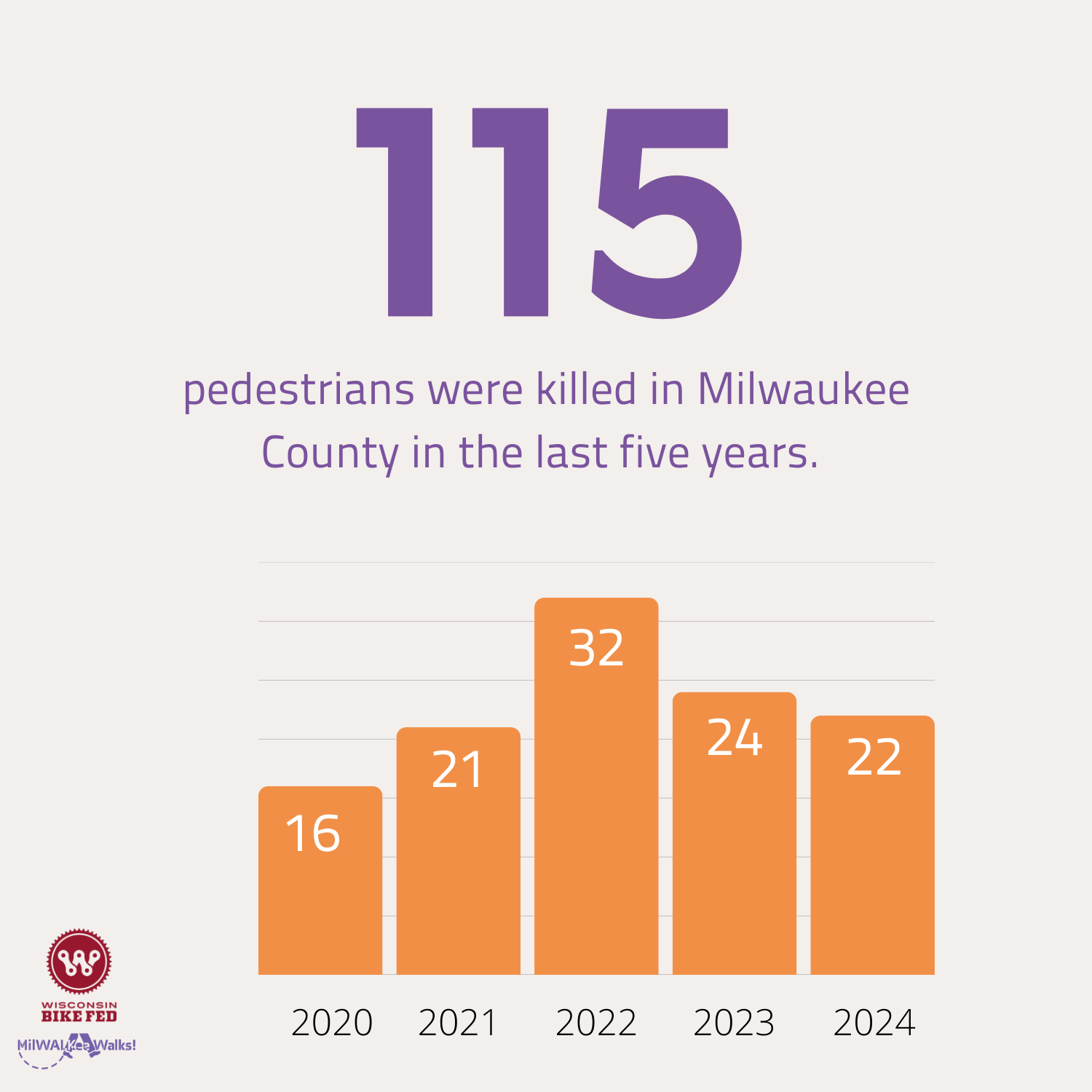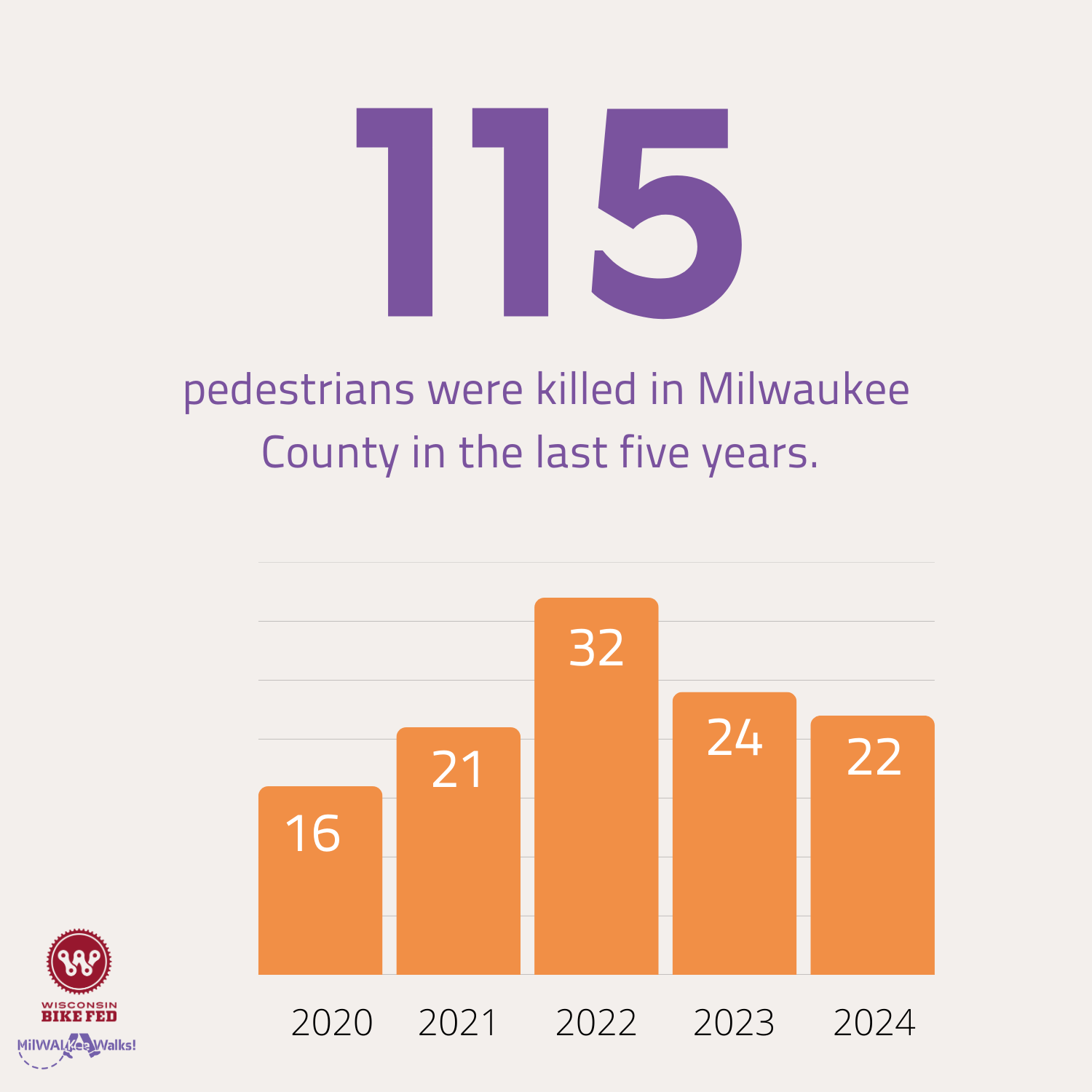
Note: Past MKE Walks analyses of pedestrian fatalities only reviewed the City of Milwaukee. This analysis is reviewing pedestrian fatalities through Milwaukee County.
2024 saw a continued downward trend in pedestrian fatalities, from 2022. While this is great news, unfortunately, these numbers are still far higher than they should be.
The only acceptable number of pedestrian deaths and life-altering injury is ZERO.
As the MilWALKee Walks team examined the pedestrian fatality crash data from 2024, we read the law enforcement crash reports and used Google Maps Street View to analyze the crash locations. We also used Community Maps and the Milwaukee County Motor Vehicle Collision Dashboard to get a better understanding of the crash landscape throughout the county.
As we looked for trends, we found that these crashes happened at all times of the day: early morning, midday, and late at night. There were instances of pedestrians being hit while crossing within crosswalks and while crossing the street outside of crosswalks. Pedestrians of all ages were involved in these crashes. There is no one single type of pedestrian fatality, which means there is no one single solution.

Hit-and-runs
Hit-and-run crashes accounted for over half (57%) of the pedestrian fatalities in Milwaukee County last year. Nationally, roughly a quarter of pedestrian fatalities involve a hit-and-run driver.1 With a proportion that more than doubles the national average, Milwaukee County is clearly experiencing a hit-and-run crisis.
“Maybe no one noticed”
When two cars crash into one another, they often make a noticeable commotion. If a car hits a pedestrian, it will produce a lower level of noise. Drivers may hope that no one noticed the crash to report it. If a pedestrian has been fatally injured, they cannot report the circumstances of the crash themselves.
Worry about severe consequences
If a driver thinks that they have fatally or severely injured a pedestrian, they may worry more about the legal consequences than they would if the crash had a less severe outcome. Driving away might feel like an option to escape those consequences. However, leaving the scene of a crash can lead to a felony charge, jail time, and increased fines.
Increased chance of pedestrian survival
Wisconsin law requires drivers involved in a pedestrian crash to stop and check on the victim and “render reasonable assistance” for any injuries.2 Reasonable assistance doesn’t mean making direct contact with the injured party by administering first aid for CPR. Reasonable assistance is as simple as calling 911. Crash survival rates increase with shorter EMS response times.3 If a driver chooses to stay at the crash site and call emergency services, the victim has a better chance of surviving.4
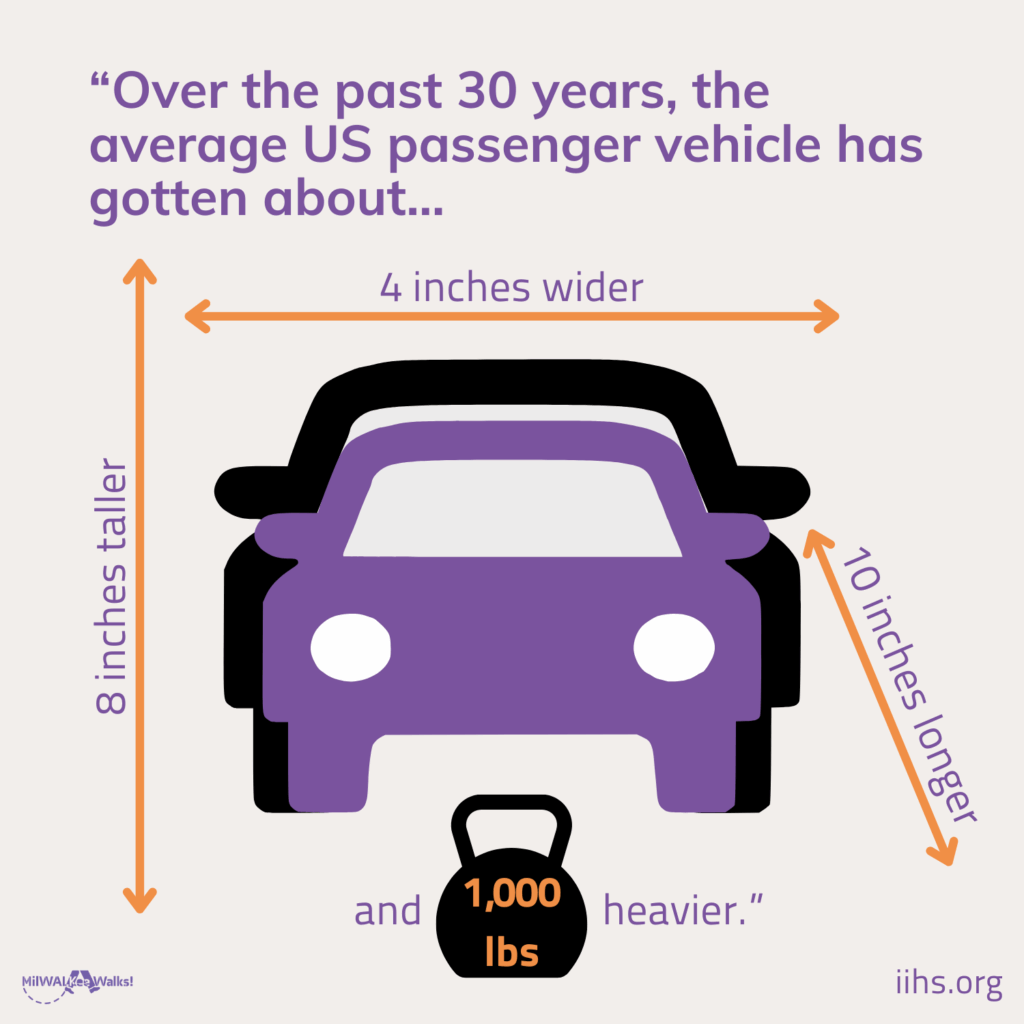
Vehicle Size
Another factor that may contribute to the numbers of pedestrian fatalities is the ever-increasing size of vehicles. Over half of the pedestrian fatalities in the county in 2024 involved an SUV, a truck, or other large vehicle. Taller hood heights and blunt nosed vehicles increase the risk of fatal injury if a pedestrian is hit. If a vehicle with a taller hood hits a pedestrian, the impact will be more centralized on their torso, near the heart, lungs, and other vital organs. Vehicles with a shorter hood height can still injure a pedestrian, but have a better chance of missing vital organs.
Smart Growth America has a great blog post about vehicle size and pedestrian deaths, if you want to learn more: Bigger vehicles are directly resulting in more deaths of people walking.

Where are crashes happening?
Crash locations are rarely random. Certain streets and intersections tend to see crashes happening at a greater frequency than other areas in the county. Factors that contribute to these “high risk” areas could be the challenging layout of an intersection, high volume/speed of traffic, or the nearby land use.
Corridors of Concern
When Milwaukee County Department of Transportation (MCDOT) drafted the Complete Communities: Comprehensive Safety Action Plan, they used crash and traffic data to determine the county’s high risk network, while also listening to residents about their concerns. The crash analysis and community feedback helped MCDOT determine the Milwaukee County Corridors of Concern. (Note: The Corridors of Concern are not the same at the City of Milwaukee’s High Injury Network. You can read about the High Injury Network in the City of Milwaukee’s Crash Analysis.)


You can see a lot of overlap between the locations of pedestrian fatalities since 2020 and the Milwaukee County Corridors of Concern. MilWALKee Walks uses this data to help us determine where to conduct Crosswalk Actions, Walk/Roll Experiences, or just chat with concerned residents.
Many of the streets highlighted in the Corridors of Concern have common characteristics. They are arterial roads with 4-6 lanes (more when you include turning lanes at intersections!), host MCTS bus routes, and experience high traffic volume.
Definition: Arterial Road
A high-capacity urban road that is designed to move cars at higher speeds over longer distances. Some examples of arterial roads in Milwaukee County include 17th St – Layton Blvd and Capitol Dr.
Arterial Roads
Arterial roads move cars at higher speeds than on smaller neighborhood streets. Posted speed limits on Milwaukee County arterial roads range from 25-40 mph, versus 20-25 mph on smaller streets. That might not sound like a huge difference, but higher speeds means it is more difficult for a driver to see a pedestrian and it takes longer for their vehicle to slow down or stop. If a driver says a pedestrian “came out of nowhere”, there is always a chance that a pedestrian rushed into the street. However, there is also the possibility that the driver was moving too fast to notice them with enough time to stop. In the case of a pedestrian fatality, we don’t have the privilege of hearing both sides of the story, and need to consider all possibilities.

Vehicle speeds also change the potential for a pedestrian to survive being struck by a vehicle. Data shows that a pedestrian has a 10% risk of death when hit by a vehicle traveling 23mph.5 That risk of death jumps to 25% when the vehicle speed increases to 32mph, and all the way to 50% when a vehicle is traveling 42mph. Pedestrians hit on higher speed arterial roads simply have a higher risk of death.
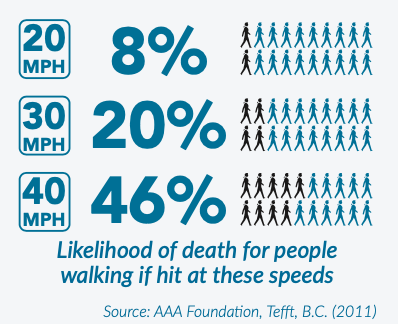
Lack of safe places to cross street & poor driver yielding
Many of the crashes from 2024 involved pedestrians crossing the street outside of a crosswalk. Did you know that there is no “jaywalking” law in Wisconsin? According to state law, pedestrians can cross where there is no intersection or crosswalk as long as they yield to vehicles.6 This means being aware of any approaching cars and using common sense to determine if you have enough time to walk across.
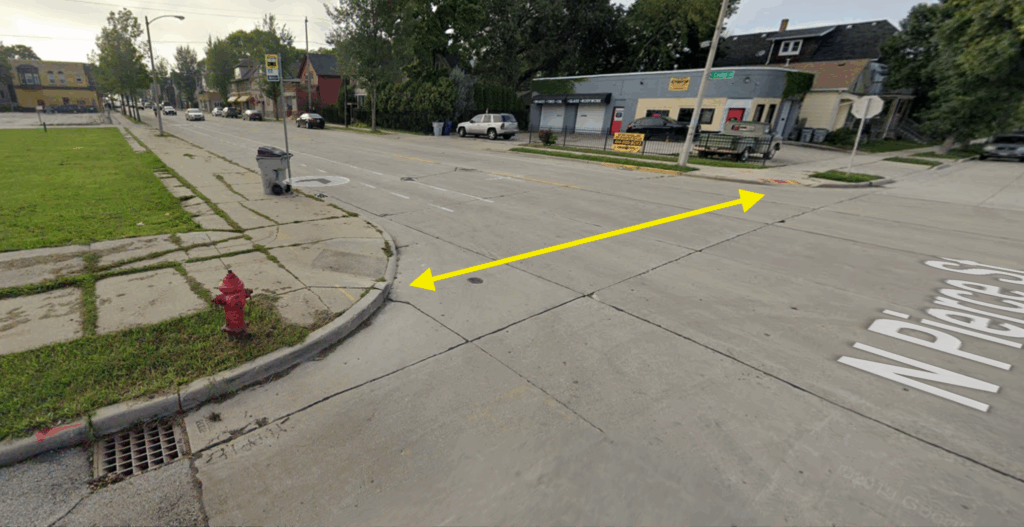

There are lots of reasons why a person may choose to cross the street somewhere other than a crosswalk or an intersection. They may have parked their car directly across the street from their destination. Or they may feel that they have to walk too far out of their way in order to reach an intersection or designated crosswalk. In some parts of Milwaukee County, marked or signalized crosswalks can be anywhere from ¼ to ¾ of a mile apart from one another. If someone is walking or rolling and the weather is unpleasant, that can feel like a long way to walk just to cross the street.
Other crashes occured when pedestrians were crossing within legal crosswalks (both marked and unmarked). Pedestrians have the right to cross at all crosswalks, and drivers must yield to them. Poor driver yielding is, unfortunately, too common. Proper street lighting that illuminates crosswalks can make it easier for drivers to see pedestrians and yield to them as they cross.
We need to think beyond drivers and personal vehicles when we design our transportation systems. When planners and community organizers consider the needs of those who walk, roll, and ride transit, we can build safer systems that create healthier communities.
How YOU can help!
Get involved with MilWALKee Walks! Signing up for our newsletter is a great way to stay in touch with us and the work that we’re doing. Our summer is jam packed with events and volunteer opportunities and we would love to have you join us! You can also request a “Yield to Pedestrian” yard sign and help us reach our goal of distributing 1500 signs across Milwaukee County.
- NHTSA. https://www.nhtsa.gov/book/countermeasures-that-work/pedestrian-safety ↩︎
- Wis. Stat. § 346.67(1)(c). https://docs.legis.wisconsin.gov/statutes/statutes/346/xi/67 ↩︎
- Byrne JP, Mann NC, Dai M, et al. Association Between Emergency Medical Service Response Time and Motor Vehicle Crash Mortality in the United States. JAMA Surg. 2019;154(4):286–293. ↩︎
- Tay, R., Barua, U., & Kattan, L. (2009). Factors contributing to hit-and-run in Fatal crashes. Accident Analysis & Prevention, 41(2), 227–233. https://doi.org/10.1016/j.aap.2008.11.002 ↩︎
- AAA Foundation for Traffic Safety. https://aaafoundation.org/impact-speed-pedestrians-risk-severe-injury-death/ ↩︎
- Wis. Stat. § 346.25. https://docs.legis.wisconsin.gov/statutes/statutes/346/iv/25?view=section ↩︎
